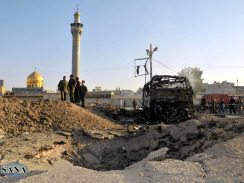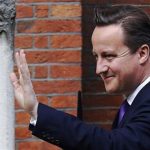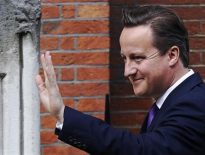BEIRUT — Smoldering buildings, looted shops, smashed cars and a strong stench of death greeted U.N. observers who entered the nearly deserted Syrian town of Haffa on Thursday, a day after President Bashar Assad’s forces overran it as part of a major offensive to recover rebel-controlled territories.

The observers had been trying to get into the town for a week after fears were raised that a brutal assault by regime forces was under way. They found the main hospital burned, state buildings and an office of the ruling Baath party in ruins and a corpse lying in the street.
“A strong stench of dead bodies was in the air,” said Sausan Ghosheh, spokeswoman for the U.N. observers. She said there was still fighting in some pockets of the mountainous town in the seaside province of Latakia.
The number of casualties was unclear, Ghosheh said, and it appeared likely that, as in the past, bodies had been removed or buried before the U.N. mission got in.
The fighting, now mostly quelled in Haffa, was mirrored in other parts of Syria, where more than 40 civilians and opposition fighters were killed Thursday, according to activists, alongside more than a half-dozen Syrian forces.
From the day’s early hours, Syrian troops bombarded rebel-held areas with tanks, mortars and helicopters in the central town of Rastan, the Damascus suburb of Douma, the central city of Homs and the northern towns of Anadan and Hreitan, near the Turkish border, the activists said.
They said the fighting included clashes in the town of Hamuriya, near Damascus, that killed at least nine men who were allegedly butchered with knives. A video circulated by activists showed a pile of lifeless men, including one who was clearly slashed through the neck.
“Slaughter, slaughter!” a person could be heard screaming in the background. Another video showed a man lying in a garden, his arm blown off. There was no way to independently confirm the content of the videos because reporters are not allowed to work freely in Syria.
For more than a week, Syrian troops have been sweeping through villages and towns in Syria’s northern, central, southern and seaside provinces, attacking rebel-held areas and opposition strongholds in what appears to be the largest offensive since an internationally-brokered cease-fire went into effect two months ago. The regime and the opposition have both largely ignored the April 12 truce.
Rami Abdul-Rahman of the Britain-based Syrian observatory for Human Rights, said it appeared the Syrian regime was trying to implement a kind of scorched earth policy in the central city of Homs, which government forces have been heavily shelling for the past week. He said the use of tanks and helicopters to smash residential buildings and city infrastructure indicated that they wanted to destroy areas, not just chase out rebels.
The U.N. observers’ description of the smoldering ruins they found in Haffa suggested Syrian forces were using intense force to quell rebels. But it also indicated the rebels were determined to smash all symbols of the hated Assad regime, including state institutions.
“Most government institutions, including the post office, were set on fire from inside,” Ghosheh said. “Archives were burnt, stores were looted and set on fire.”
She said homes were broken into, while the ruling Baath party headquarters was shelled, “and appeared to be the scene of heavy fighting.” The observers also found remnants of heavy weapons scattered through the town; it was not clear who they belonged to.
On Tuesday, an angry crowd hurled rocks and sticks at the U.N. mission’s vehicles near Haffa, forcing them to turn back. But the Syrian government urged them to enter after they announced Wednesday that they had “cleansed” Haffa of “armed terrorist groups” — the regime’s term for rebel fighters.
The U.N. observers’ visit to Haffa came hours after a suicide bomber detonated a van packed with explosives in a Damascus suburb, wounding 14 people and damaging one of Shiite Islam’s holiest shrines, according to witnesses and Syria’s state-run news agency.
It was not immediately clear whether the bomber intended to target the golden-domed Sayyida Zainab complex or a police station 15 yards (meters) away. Believed to house the remains of the granddaughter of Islam’s Prophet Muhammad, the shrine attracts tens of thousands of Shiite pilgrims from around the world.
U.N. observers have reported a steep rise in violence and a dangerous shift in tactics by both sides in Syria in recent weeks. Car bombs and suicide bombings have become increasingly common as the 15-month uprising against Assad becomes militarized. Most have targeted security buildings and police buses, symbols of Assad’s regime.
In Rastan, a rebel-held town that was heavily bombed Thursday, two rights groups said the dead included Maj. Ahmad Bahbouh, an army defector who headed the town’s opposition military council. Activists said helicopters pounded the town, which has been held by rebels for months.
They said troops also heavily bombed the Damascus suburb of Douma killing at least five people. Abdul-Rahman said Syrian forces seized control of the northern town of Hreitan, where they conducted house-to-house raids and set homes of anti-government activists on fire.
An amateur video from the nearby town of Anadan, showed two babies receiving treatment in a makeshift hospital. One baby, screaming in pain, had part of his left foot blown off and severe head injuries. A third baby was dead and covered with a blanket. Activists said the children were the victims of government shelling. There was no way to verify the claim.
Activists say some 14,000 people have been killed since the uprising against Assad began in March 2011.
A military expert said it was unlikely that Assad’s forces would be able to defeat the insurgency.
“Rebels are not seeking to hold ground, but to confuse, exhaust and bleed out army forces by attacking them in different areas simultaneously,” said Elias Hanna, a retired Lebanese army general.
He said the army’s response — typical of conventional forces — was to heavily shell the rebels’ urban hideouts, which “creates more opposition against the regime, because it inflicts heavy civilian casualties, and damages and destroys their communities.”
As the violence grows more chaotic, it is difficult to assign blame for much of the bloodshed. Western officials say there is little doubt that Islamist extremists, some associated with al-Qaida, have made inroads in Syria as instability has spread.





